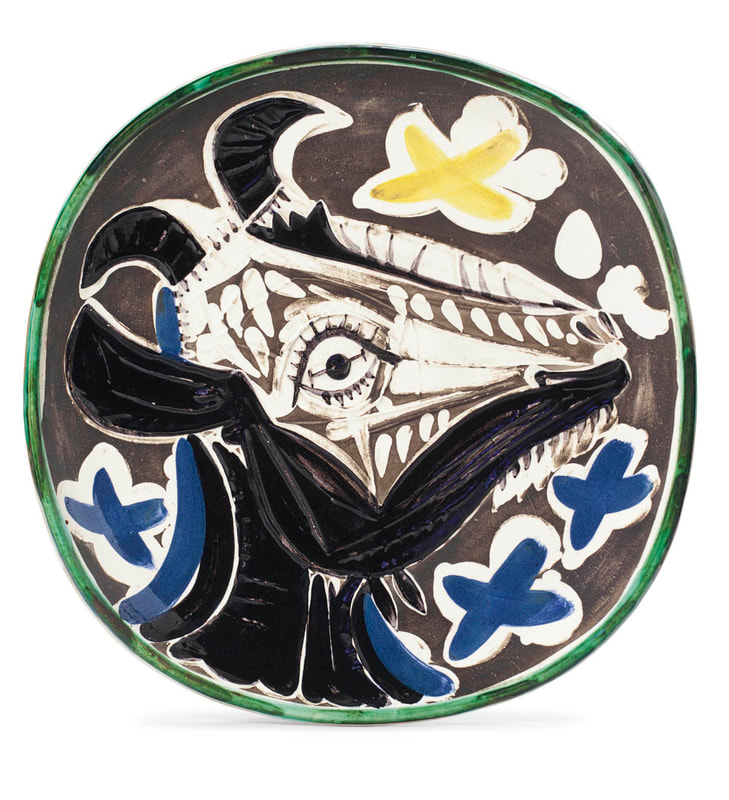Picasso Ceramics
Huxley-Parlour Gallery
18 March – 30 April 2020
3-5 Swallow Street,
London
W1B 4DE
How brilliant is this! A rare opportunity to see some amazing examples of Picasso's, well dare I say lesser known art medium? They are all gorgeous, you'll notice I put my favourite above can't wait to see it up close. The exhibited ceramics largely date from the early 1950s & measure between 9 and 15 inches in height or length. I've put a big slide show of some of the pieces but you know as well as I do that to appreciate this work you'll have to visit the exhibition. See you there! Best pp
About
A new exhibition of Pablo Picasso’s ceramics opens in March at Huxley-Parlour Gallery. It is believed to be the first time the artist’s ceramics will be exhibited as a solo show in a commercial gallery in London.
Picasso’s ceramic works have generated significant interest in recent years. With subjects varying from Greek mythological figures, animals, faces and even scenes of the Spanish corrida, his pieces are united by an accessible and playful aesthetic that carries the recognisable hand of Picasso. The selection exhibited at Huxley-Parlour, featuring female muses, faces and curious animals in unique designs and unusual shapes, speaks to the variety of the artist’s practice and its enduring appeal over time.
Picasso’s ceramic works have generated significant interest in recent years. With subjects varying from Greek mythological figures, animals, faces and even scenes of the Spanish corrida, his pieces are united by an accessible and playful aesthetic that carries the recognisable hand of Picasso. The selection exhibited at Huxley-Parlour, featuring female muses, faces and curious animals in unique designs and unusual shapes, speaks to the variety of the artist’s practice and its enduring appeal over time.
Picasso’s ceramics are predominantly the result of a 25-year collaboration with the Madoura Pottery workshop in Vallauris, where he met his muse and second wife Jacqueline Roque. During this period, which spanned from 1946 to his death in 1973, he produced over 600 pieces, originating from more than 3,500 ceramic designs. Intended to be accessible and easily affordable, Picasso created editions of up to 500 pieces, the result of a prolific practice and continuously evolving style.
From elegant plates and platters to intricate and imaginative pitchers and vases, the pieces exhibited will reveal the breadth of the artist’s innovative practice in clay. Works of note include a delicate white plate depicting the profile of Jacqueline Roque, and a number of his decorated statuettes of owls. Further whimsical and unusual pieces include Figure de Proue, a white ceramic vessel colourfully glazed and shaped to resemble a figurehead found on the bow of a ship, and Pichet a Glace, which takes on human features and is recognisable due to its bulbous spout, short round handle and opening for filling water.
Picasso drew his inspiration from the summer light and Mediterranean colours of the Cote D’Azur in the South of France. These are reflected in the sinuous forms and delicate colours of his wares, largely blue, black and earthy tones. The shapes of the various pieces speak to Picasso’s many sources of inspiration, including his fascination with classical antiquity. Amphoras, or tall vases with two handles, echo the silhouette of ancient Greek vases. Conversely, bourrache, or pitchers with a long neck often used to contain oil, reflect local craftsmanship and are characteristic of the Provençal region of France.
As in Picasso’s prolific painted oeuvre, his use of vigorous, abstracted brushstrokes give life and vibrancy to his ceramic subjects. In some cases, the arms of pitchers are turned into extensions of the figures themselves, becoming the anatomical features of the animals depicted. These works in particular demonstrate the evolution of Picasso’s practice, having begun with mostly utilitarian items such as plates or bowls and having progressed to more complex forms.
As in Picasso’s prolific painted oeuvre, his use of vigorous, abstracted brushstrokes give life and vibrancy to his ceramic subjects. In some cases, the arms of pitchers are turned into extensions of the figures themselves, becoming the anatomical features of the animals depicted. These works in particular demonstrate the evolution of Picasso’s practice, having begun with mostly utilitarian items such as plates or bowls and having progressed to more complex forms.
Throughout his later career, Picasso experimented with a variety of ceramic techniques, including oxides and glazes, firing processes and engravings. He adopted two main styles: the precise replication of an object and the creation of unique designs using dry clay moulds. Works of the latter kind are distinguished by the mark ‘Empriente Originale de Picasso’. Every piece contains a stamp or marking. The most common, featured on all exhibited pieces, include ‘Madoura Plein Feu’, which verifies the edition’s authenticity and provenance, and ‘Edition Picasso’, limited editions authorised by the artist and created at the Madoura factory.
Picasso prioritised the functionality of his ceramics. Many of his first pieces were used in his own home or gifted to friends. In contrast to the elevated prices of his paintings and sculptures, his ceramics were both accessible and easily available. Reflective of Picasso’s unmistakable style, they provided then as they do now a unique key into one of the twentieth century’s most influential artists.
share






